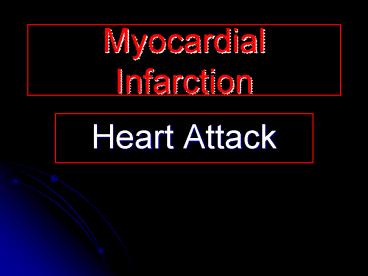Myocardial Infarction - PowerPoint PPT Presentation
1 / 16
Title:
Myocardial Infarction
Description:
Blockage of a coronary artery deprives the heart muscle of blood & oxygen, ... Pressure, heaviness, squeezing or aching across the chest. ... – PowerPoint PPT presentation
Number of Views:120
Avg rating:3.0/5.0
Title: Myocardial Infarction
1
Myocardial Infarction
- Heart Attack
2
Outline
- What is an MI (or) Heart Attack
- What are the causes?
- Patho-physiology (disease process)
- What are the signs symptoms?
- Management of diagnosis treatment
- (How is it diagnosed how is it treated?)
3
What is a MI / Heart Attack?
- A heart attack (a.k.a. Myocardial Infarction) is
the death of heart muscle from a sudden blockage
of a coronary artery. - Blockage of a coronary artery deprives the heart
muscle of blood oxygen, causing injury to the
heart muscle.
4
Etiology (cause)
- Risk factors for developing heart attacks are
- Atherosclerosis
- Angina
- HBC (High Blood Cholesterol) A high level of
cholesterol in the blood - HBP (High Blood Pressure/Hypertension)
- Tobacco Use (Smoking)
- Diabetes
- Family History of Heart Disease
5
Etiology (contd)
6
Patho-physiology (disease process )
- Atherosclerosis
- Which is a gradual
- process of plaques or
- collections of
- cholesterol are
- deposited in the artery
- walls.
Cross Section of Artery With Atherosclerosis
Artery Wall
Endothelium (Inner artery wall lining)
Fatty Deposits of plaque
7
Patho-physiology (contd)
- Angina
- This is chest pain
- that occurs when the
- blood oxygen supply
- to the heart muscle
- cannot keep up with the
- needs of the heart
- muscle.
endothelium
Artery wall
plaque
8
Signs Symptoms
- Common symptoms of atherosclerosis angina are
- Pressure, heaviness, squeezing or aching across
the chest. - Pain may travel to the neck, jaw, arms, back,
even teeth, and may be accompanied by shortness
of breath, nausea, or cold sweat.
9
Signs Symptoms (contd)
- Angina can also occur during rest. Angina at rest
more commonly indicates that a coronary artery
has been narrowed to a critical degree. The heart
is NOT receiving enough oxygen even at rest.
10
Management (Diagnosis)
- Severe chest pain is usually a sign that a MI or
heart attack is occurring, and tests can be
performed that will confirm the MI. - When symptoms of a heart attack do not include
chest pain, the heart attack may not be suspected
and appropriate tests may not be performed. - The initial step in diagnosing a heart attack is
to be suspicious that one has occurred.
11
FYI
- About 160,440 people die each year from a heart
attack.
12
Management (Diagnosis)
(contd)
Upside down ST Segment
Post Myocardial Infarction
Post Myocardial Infarction
- (Pic 1) The patient clearly has risk factors for
coronary artery disease, symptoms suggestive of
angina and an abnormal ECG. - (Pic 2) ECG as it appears while patient is
having a MI. During heart attack, notice the
atrial ventricular spikes. - (Pic 3) The patient has had a MI.
13
Management (Diagnosis)
(contd)
- There are different ways to diagnose a heart
attack. - Electrocardiogram (ECG/EKG)
- Blood Tests
- The most important factor in diagnosing a heart
attack is prompt medical attn
14
Management (Treatment)
- But, what is an Electrocardiogram (ECG/EKG)?
- It is a recording of the electrical activity of
the heart. - It can identify the areas of heart muscle that
are deprived of oxygen /or areas of muscle that
have died. - It can also give a secure diagnosis of a heart
attack, it can be made quickly in the ER so
treatment can be started immediately.
15
Management (Treatment)
(contd)
- How is a heart attack treated?
- Anti-platelet medications to prevent formation of
blood clots in the arteries. - Anti-coagulants to prevent growth of blood clots
in the arteries. - Clot- dissolving medications to open blocked
arteries. - Medications to prevent abnormal heart rhythms.
- Supplemental oxygen to increase the supply of
oxygen to the heart muscle.
16
Conclusion
- So as we have discussed learned what an MI is,
how its diagnosed treated, what will you do to
prevent one or at the least lower your chances of
having one? - We can all do our own part in answering that
question for ourselves. - Thank You

